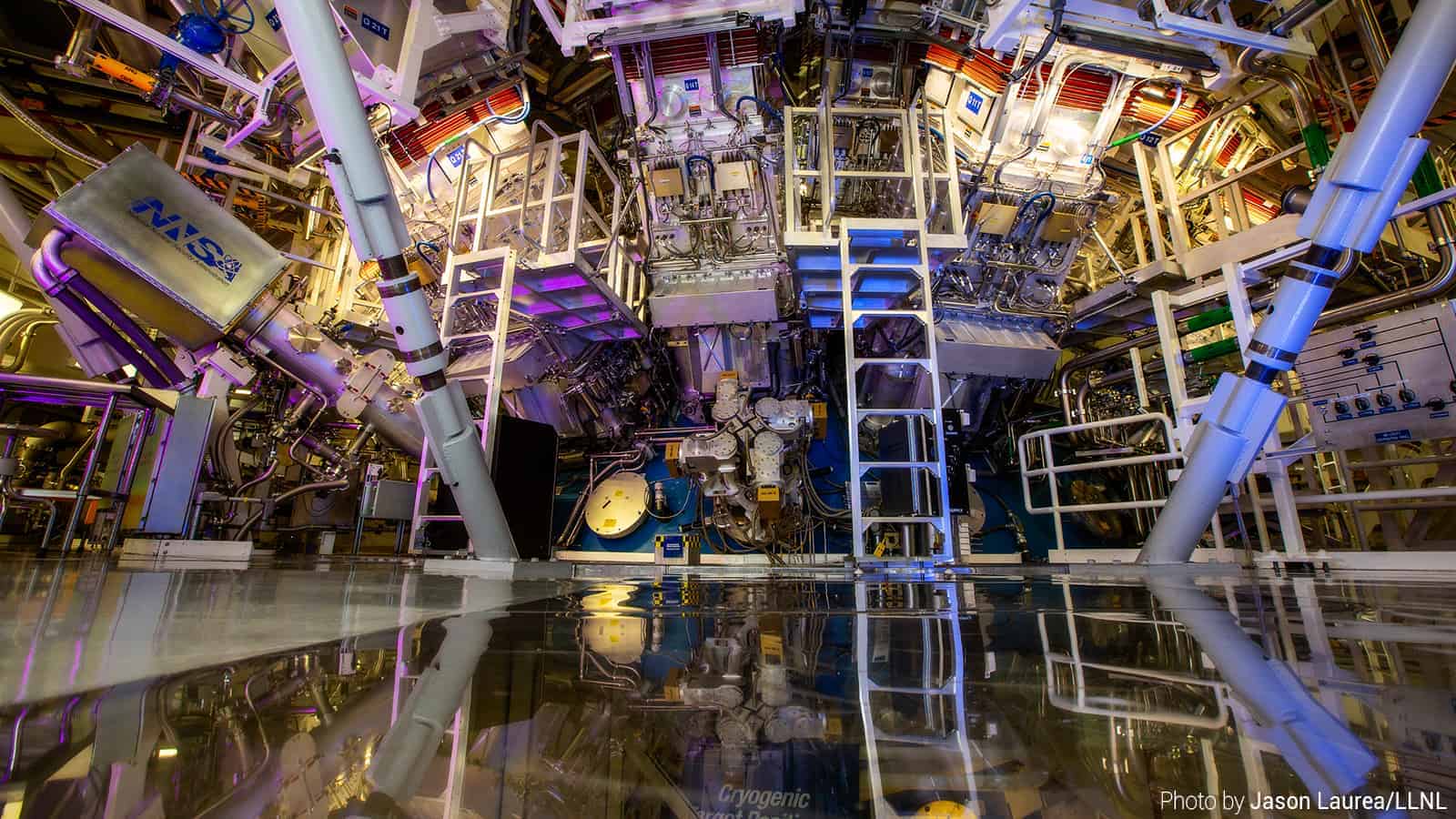Last month, scientists at the Lawrence Livermore National Laboratory in California achieved a milestone in nuclear fusion research. The researchers produced more than ten quadrillion watts of power using an experimental nuclear fusion reactor. They accomplished this by firing an array of laser beams at a pea-sized hydrogen capsule. This record-breaking experiment marks a turning point in fusion research and could help fight for clean energy.
Fusion occurs when two atoms slam together, forming a heavier atom. This process powers the sun and generates enormous amounts of energy. Fusion reactions are typically short-lived since they require tremendously high pressure and temperatures to fuse the nuclei.
At the laboratory’s National Ignition Facility (NIF), giant, powerful lasers reproduce similar temperatures and pressures as those within the sun, other stars, and nuclear weapons.
A giant leap forward, but a fusion reactor is still a future technology
The team focused 192 of the world’s largest lasers at the National Ignition Facility (NIF) onto a BB-sized pellet. This resulted in a hot spot no larger than a human hair, releasing 1.3 megajoules of energy in 100 trillionths of a second. While the energy blast was brief, a chief scientist for the fusion program called it a “Wright Brothers moment.”To put it in perspective, the energy produced equates to 10% of the energy from the sun hitting Earth. It also amounts to about 70% of the power that the hydrogen capsule absorbed from the lasers. Scientists hope that in the future, they will reach fusion ignition. This is the point at which the reaction generates more energy than it uses.
However, the energy produced in the experiment far surpassed scientists’ expectations. They set a prior record of 170 kilojoules in February 2021, making this second experiment a victory.
The team hopes the discovery will enhance their nuclear fusion weapons research, the NIF’s primary focus. It may also lead to improved, sustainable energy using nuclear fusion. While that’s a ways off, the study provides promise for a future without fossil fuels.
“This result is a historic step forward for inertial confinement fusion research, opening a fundamentally new regime for exploration and the advancement of our critical national security missions,” Kim Budil, the director of Lawrence Livermore National Laboratory, said in a statement.
NIF’s revolutionary nuclear fusion reactor is an improvement in nuclear energy
Modern nuclear power plants produce energy using nuclear fission when a neutron slams into a larger atom. The atom then splits into two smaller, lighter particles, which release massive amounts of energy. Elements like uranium and plutonium are most commonly used in fission reactions. The nuclear fission process heats water into steam, which then spins a turbine to create clean energy.
On the other hand, fusion can create several times more energy than fission without producing radioactive byproducts. Most previous experiments on fusion energy use doughnut-shaped chambers called tokamaks. These machines confine a plasma of hot, electrically charged hydrogen inside massive magnetic coils lining the chamber. As the plasma heats up, it releases large amounts of energy.
For over 60 years, scientists have attempted to produce sustainable energy using tokamaks with little success. However, by 2025, scientists from MIT believe they can create the world’s first sustainable fusion reactor.
The experimental reactor developed at the Lawrence Livermore National Laboratory doesn’t use a tokamak. Instead, it focuses lasers the size of three football fields on hydrogen fuel pellets. These pellets are placed in a 33-foot-wide spherical metal “target chamber.” The world’s most powerful lasers can produce up to 4 megajoules of energy.
Scientists initially developed the method to study the behavior of hydrogen in nuclear weapons, called hydrogen bombs. They also think it could have important implications for energy production using nuclear fusion. However, it’s still a future technology that requires much more intensive testing and research.
The results haven’t been published in a peer-reviewed journal yet, but scientists from the laboratory said that would occur. Since the news of the vast achievement spread fast, they wanted to get the facts out regardless.
Fusion energy for commercial power production
The NIF’s lasers can only fire about once per day, so the method isn’t viable for commercial use. Power plants would need to vaporize several hydrogen capsules each second, which may be possible in the future.
Scientists at the SLAC National Accelerator Laboratory at Stanford have worked on a rapid-fire laser system that requires less energy. Siegfried Glenzer, a plasma physicist, hopes that nuclear fusion energy will become a viable replacement for fossil fuels. He used to work at the Livermore laboratory but wasn’t involved in the recent research.
“This is very promising for us, to achieve an energy source on the planet that won’t emit CO2,” he said about the laser system in a New York Times article.
Physicist Stephen Bodner, who formerly headed laser plasma research at the Naval Research Laboratory in Washington, D.C., said this about NIF’s research in the Times interview:
“They have come close enough to their goal of ignition and break-even to call it a success. It is time for the U.S. to move ahead with a major laser fusion energy program.”
Advantages of nuclear energy
- It’s the second-largest source of low-carbon electricity worldwide, behind hydropower.
- It produces zero emissions, using heat to produce energy. According to the Nuclear Energy Institute (NEI), the nuclear industry helped to avoid over 471 million metric tons of carbon dioxide emissions in 2020.
- Nuclear energy plants don’t require much land. According to the Department of Energy, a typical 1,000-megawatt nuclear facility in the US needs a little over 1 square mile to operate. Compare that to wind farms, which require 360 times more land to produce the same electricity.
Final Thoughts: A record-breaking nuclear fusion reactor generates ten quadrillion watts of power
In August, scientists successfully created a nuclear fusion reactor capable of generating ten quadrillion watts of power. While the reaction lasted not even a second, it marks a considerable step in nuclear fusion research. Scientists hope that nuclear fusion could provide a sustainable energy source to replace fossil fuels in the future.
















 Community
Community

